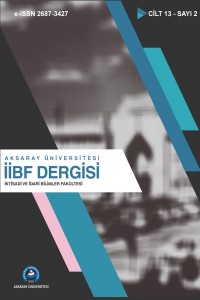COVID-19 Sürecinde Çevrimiçi İkinci El Ürün Alışverişine Yönelik Tutum ve Satın Alma Niyeti Üzerine Bir Araştırma
Abstract
COVID-19 süreci insanların yaşam tarzında bir takım değişikliklere yol açmış ve özellikle bireyleri çevrimiçi alışverişe yönlendirmiştir. Çevrimiçi alışverişin tüketiciler tarafından yaygın ve hızlı bir şekilde benimsenmesi ile birlikte ikinci el alışveriş için de çevrimiçi platformlar önemli bir seçenek halini almıştır. Bu çalışmada tüketicilerin ikinci el çevrimiçi alışverişinde algıladıkları kullanışlılık, kullanım kolaylığı, hijyen, teslimat, güvenlik ve fiyat değişkenlerinin çevrimiçi alışveriş tutumu ve ikinci el satın alma niyeti üzerindeki etkisi üzerinde durulmaktadır. Çevrimiçi anket yöntemiyle 467 tüketiciden toplanan veri PLS-SEM Kısmi En Küçük Kareler Yapısal Eşitlik Modellemesi ile incelenmiştir. Araştırma sonucuna göre çevrimiçi ikinci el alışverişe yönelik tutumda tüketicilerin güvenlik, fiyat ve kullanışlılığa yönelik algılarının anlamlı etkisi tespit edilmiştir. Buna karşın, hijyen, teslimat ve kullanım kolaylığı değişkenleri için benzer bir etki görülmemiştir. Araştırmanın diğer bir sonucu ise ikinci el alışverişe yönelik tutumun satın alma niyeti üzerindeki belirleyici rolüdür.
References
- Amatulli, C., Pino, G., Angelis, M. D., & Cascio, R. (2018). Understanding purchase determinants of luxury vintage products. Psychology and Marketing, 35(8), 616-624.
- Balasubraman, S., Raghunathan, R., & Mahajan, V. (2005). Consumers in a multichannel environment: Product utility, process utility, and channel choice. Journal of Interactive Marketing, 19(2), 12-30.
- Bilgin, O. (2020). Koronavirüs (Covid-19) farkındalık ölçeği geliştirilmesi: Geçerlik ve güvenirlik çalışması. Turkish Studies, 15(6), 237-245.
- Chin, W. W. (1998). The partial least squares approach for structural equation modeling. In G. A. Marcoulides (Ed.), Methodology for business and management. Modern methods for business research (p. 295-336). Lawrence Erlbaum Associates Publishers.
- Davis, F. D. (1989). Perceived usefulness, perceived ease of use, and user acceptance of information technology. MIS Quarterly, 13(3), 319-340.
- Fishbein, M., & Ajzen, I. (1975). Belief, Attitude, Intention, and Behavior: An Introduction to Theory and Research. Reading, MA: Addison-Wesley.
- Fornell, C., & Larcker, D. F. (1981). Evaluating structural equation models with unobservable variables and measurement error. Journal of Marketing Research, 18(1), 39-50.
- Gefen, D., Karahanna, E., & Straub, D. W. (2003). Trust and TAM in online shopping: an integrated model. MIS Quarterly, 27(1), 51-90.
- Guiot, D., & Roux, D. (2010). A second-hand shoppers’ motivation scale: Antecedents, consequences, and ımplications for retailers. Journal of Retailing, 86(4), 355-371.
- Ha, S., & Stoel, L. (2009). Consumer e-shopping acceptance: Antecedents in a technology acceptance model. Journal of Business Research, 62(5), 565-571.
- Hair, J. F., Hult, G. T. M., Ringle, C. M., & Sarstedt, M. (2014). A Primer on Partial Least Squares Structural Equation Modeling. Thousand Oaks: Sage.
- Hair, J. F., Ringle, C. M., & Sarstedt, M. (2011). PLS-SEM: Indeed a silver bullet. The Journal of Marketing Theory and Practice, 19(2), 139-152.
- Hvass, K. K. (2015). Business model innovation through second-hand retailing: A fashion industry case. Journal of Corporate Citizenship, 57, 11-32.
- Kessous, A., & Valette-Florence, P. (2019). “From Prada to Nada”: Consumers and their luxury products: A contrast. Journal of Business Research, 102, 313-327.
- Kim, H.-W., Xu, Y., & Gupta, S. (2012). Which is more important in Internet shopping, perceived price or trust? Electronic Commerce Research and Applications, 11, 241-252.
- Legris, P., Ingham, J., & Collerette, P. (2003). Why do people use information technology? A critical review of the technology acceptance model. Information & Management, 40, 191-204.
- Padmavathy, C., Swapana, M., & Paul, J. (2019). Online second-hand shopping motivation – Conceptualization, scale. Journal of Retailing and Consumer Services, 51, 19-32.
- Reichheld, F. F., Markey, R. G., & Hopton, C. (2000). E-customer loyalty applying the traditional rules of business for online success. European Business Journal, 12(4), 173-179.
- Rosenbaum E., & Caminiti, S. (2020). Coronavirus and luxury retail: Shopping for used Hermes, Cartier in Covid era. CNBC: https://www.cnbc.com/2020/09/19/coronavirus-how-the-pandemic-has-impacted-luxury-retail.html adresinden edinilmiştir.
- Sevim, N., Yüncü, D., & Eroğlu Hall, E. (2017). Analysis of the extended technology acceptance model in online travel products. Internet Uygulamaları ve Yönetimi, 8(2), 45-61.
- Sihvonen, J., & Turunen, L. L. (2016). As good as new-valuing fashion brands in the online second-hand markets. Journal of Product & Brand Management, 25(3), 285-295.
- Shih, H.-P. (2004). An empirical study on predicting user acceptance of e-shopping on the web. Information & Management, 41(3), 351-368.
- Telli Yamamoto, G. (2013). E-ticaret kavramlar gelişim ve uygulamalar. İstanbul: Kriter Yayınları.
- ThredUp. (2020). 2020 resale report. ThredUp: https://www.thredup.com/resale/static/thredup- resaleReport2020-42b42834f03ef2296d83a44f85a3e2b3.pdf adresinden edinilmiştir.
- Turunen, L. L., Cervellon, M.-C., & Carey, L. D. (2019). Selling second-hand luxury: Empowerment and enactment of social roles. Journal of Business Research, 116, 474-481.
- Vasic, N., Kilibarda, M., & Kaurin, T. (2018). The influence of online shopping determinants on customer satisfaction in the Serbian market. Journal of Theoretical and Applied Electronic Commerce Research, 14(2), 70-89.
- Vijayasarathy, L. R. (2004). Predicting consumer intentions to use on-line shopping: The case for an augmented technology acceptance model. Information and Management, 41(6), 747-762.
- Wen, Z., Huimin, G., & Kavanaugh, R. R. (2005). The impacts of SARS on the consumer behaviour of Chinese domestic tourists. Current Issues in Tourism, 8(1), 22-38.
- Yaşlıoğlu, M. M. (2017). Sosyal bilimlerde faktör analizi ve geçerlilik: Keşfedici ve doğrulayıcı faktör analizlerinin kullanılması. Istanbul University Journal of the School of Business, 46(Özel sayı), 74-85.
- Yılmaz, C., & Tümtürk, A. (2015). İnternet üzerinden alışveriş niyetini etkileyen faktörlerin genişletilmiş teknoloji kabul modeli kullanarak incelenmesi ve bir model önerisi. Yönetim ve Ekonomi, 22(2), 355-384.
- Yılmaz, E. S., & Mutlu, H. M. (2020). Online Market Alışverişinin (Kuru Gıda, Yaş Meyve Sebze ve Paketli Gıda Ürünleri vb.) Benimsenmesi: Covid-19 Anksiyetesinin Düzenleyici Rolü. Gaziantep University Journal of Social Sciences, 2020 Special Issue, 486-505.
Details
| Primary Language | Turkish |
|---|---|
| Subjects | Business Administration |
| Journal Section | Research Article |
| Authors | |
| Publication Date | June 18, 2021 |
| Published in Issue | Year 2021 Volume: 13 Issue: 2 |

